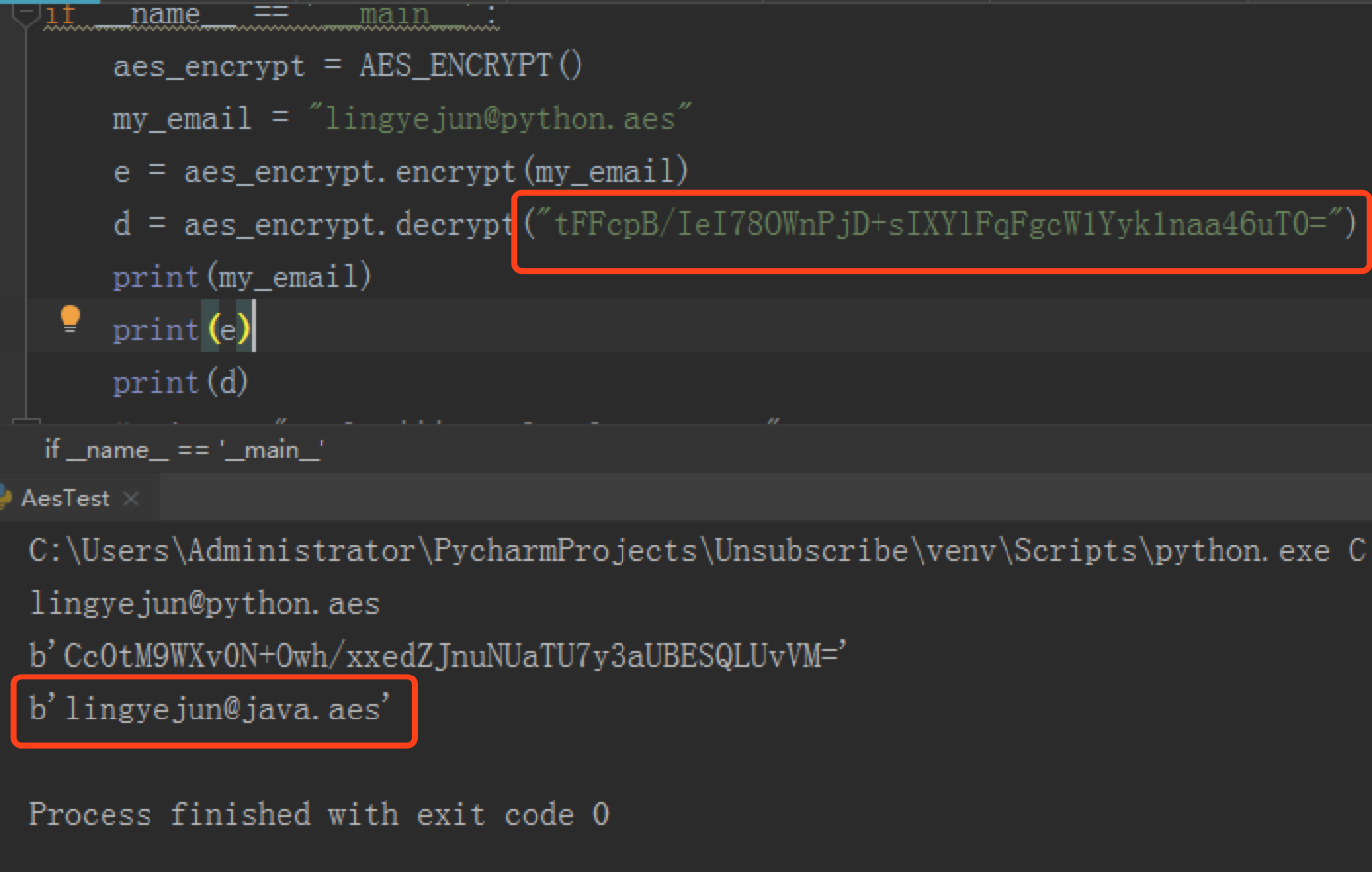最新版-Python和Java实现Aes相互加解密
前情
需要使用Python和Java实现同一个AES加解密算法,使Python版本加密的密文能够由Java代码解密,反之亦然。
Python实现
Python为3.6版本
# -*- coding: utf-8 -*-
import base64
from Crypto.Cipher import AES
from urllib import parse
AES_SECRET_KEY = 'lingyejunAesTest' #此处16|24|32个字符
IV = "1234567890123456"
# padding算法
BS = len(AES_SECRET_KEY)
pad = lambda s: s + (BS - len(s) % BS) * chr(BS - len(s) % BS)
unpad = lambda s: s[0:-ord(s[-1:])]
class AES_ENCRYPT(object):
def __init__(self):
self.key = AES_SECRET_KEY
self.mode = AES.MODE_CBC
#加密函数
def encrypt(self, text):
cryptor = AES.new(self.key.encode("utf8"), self.mode, IV.encode("utf8"))
self.ciphertext = cryptor.encrypt(bytes(pad(text), encoding="utf8"))
#AES加密时候得到的字符串不一定是ascii字符集的,输出到终端或者保存时候可能存在问题,使用base64编码
return base64.b64encode(self.ciphertext)
#解密函数
def decrypt(self, text):
decode = base64.b64decode(text)
cryptor = AES.new(self.key.encode("utf8"), self.mode, IV.encode("utf8"))
plain_text = cryptor.decrypt(decode)
return unpad(plain_text)
if __name__ == '__main__':
aes_encrypt = AES_ENCRYPT()
my_email = "lingyejun@python.aes"
e = aes_encrypt.encrypt(my_email)
d = aes_encrypt.decrypt(e)
print(my_email)
print(e)
print(d)

Java实现
import sun.misc.BASE64Decoder;
import sun.misc.BASE64Encoder;
import javax.crypto.Cipher;
import javax.crypto.spec.IvParameterSpec;
import javax.crypto.spec.SecretKeySpec;
public class AesTest {
/**
* 加密用的Key 可以用26个字母和数字组成
* 此处使用AES-128-CBC加密模式,key需要为16位。
*/
private static String sKey = "lingyejunAesTest";
private static String ivParameter = "1234567890123456";
// 加密
public static String encrypt(String sSrc) throws Exception {
Cipher cipher = Cipher.getInstance("AES/CBC/PKCS5Padding");
byte[] raw = sKey.getBytes();
SecretKeySpec skeySpec = new SecretKeySpec(raw, "AES");
IvParameterSpec iv = new IvParameterSpec(ivParameter.getBytes());//使用CBC模式,需要一个向量iv,可增加加密算法的强度
cipher.init(Cipher.ENCRYPT_MODE, skeySpec, iv);
byte[] encrypted = cipher.doFinal(sSrc.getBytes("utf-8"));
return new BASE64Encoder().encode(encrypted);//此处使用BASE64做转码。
}
// 解密
public static String decrypt(String sSrc) {
try {
byte[] raw = sKey.getBytes("ASCII");
SecretKeySpec skeySpec = new SecretKeySpec(raw, "AES");
Cipher cipher = Cipher.getInstance("AES/CBC/PKCS5Padding");
IvParameterSpec iv = new IvParameterSpec(ivParameter.getBytes());
cipher.init(Cipher.DECRYPT_MODE, skeySpec, iv);
byte[] encrypted1 = new BASE64Decoder().decodeBuffer(sSrc);//先用base64解密
byte[] original = cipher.doFinal(encrypted1);
String originalString = new String(original, "utf-8");
return originalString;
} catch (Exception ex) {
return null;
}
}
public static void main(String[] args) {
String email = "lingyejun@java.aes";
try {
String sec = encrypt(email);
System.out.println(sec);
System.out.println(decrypt("CcOtM9WXv0N+Owh/xxedZJnuNUaTU7y3aUBESQLUvVM="));
} catch (Exception e) {
e.printStackTrace();
}
}
}

再将Java代码加密出来的密钥放到Python中进行解密

大功告成,实现了AES在Java和Python的互转。
出处:http://www.cnblogs.com/lingyejun/
若本文如对您有帮助,不妨点击一下右下角的【推荐】。
如果您喜欢或希望看到更多我的文章,可扫描二维码关注我的微信公众号《翎野君》。
转载文章请务必保留出处和署名,否则保留追究法律责任的权利。


